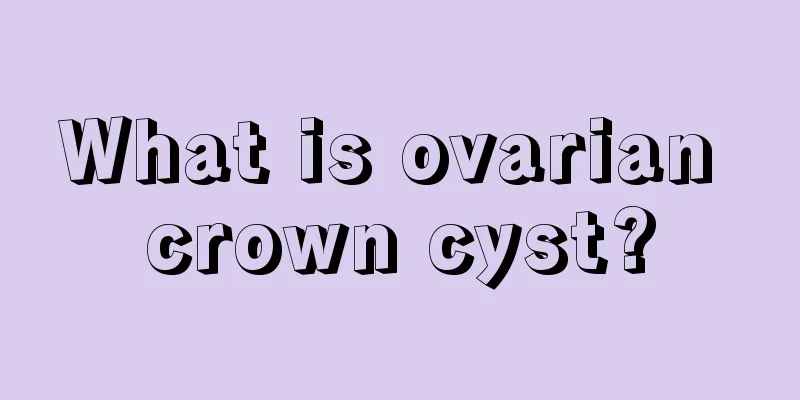What is ovarian crown cyst?

|
Ovarian cysts are cysts located within the broad tendon close to the bilateral fallopian tubes or uterus and ovaries. The name of ovarian crown cyst does not involve histogenesis, but only indicates some cystic masses around the bilateral fallopian tubes, uterus and ovaries, and between the two leaves of the broad muscle tendon. What is the cause of ovarian cysts? Ovarian corona cysts are not ovarian cysts but belong to tumor-like diseases. Causes The uterine ovarian crown originally refers to the cranial side of the mesonephric duct during the test tube embryonic period, including the longitudinal duct and 10 to 15 short transverse tubules connected to it. At present, it is believed that there are three histological origins: mesonephric duct (Wolffer's duct) origin, paramesonephric duct (Steg's duct) origin, and mesothelial origin. The mesonephric duct tissue may remain intermittently or partially during the development of the female embryo, and then form a cyst. Cysts arising from the paramesonephric duct are generally large and rarely develop but can develop into junctional ovarian cysts. Clinical symptoms Cysts may exist at a young age and may be discovered during gynecological examinations or B-ultrasound examinations. The cysts are small, usually asymptomatic, and rarely exceed 10 cm in diameter. After puberty, as endocrine function begins to increase, the metabolic activity of the squamous epithelial cells in the cavity increases, resulting in cyst expansion and causing the disease. 1. Acute abdominal pain Ovarian corona cysts are rarer than general ovarian cysts, and their sizes vary significantly. The smallest one is 1 to 2 cm in diameter, while the largest one is nearly 20 cm. The average diameter is around 8 cm. Generally, ovarian crown cysts are located within the broad muscle tendon and have little mobility, so they are not easily twisted. A small number of pedunculated cysts located at the ends of the fallopian tubes may cause twisting and severe pain. The disease usually affects one side, but in a small number of unilateral patients, the disease worsens and eventually develops into actual cancer. 2. Oppressed Diseases Large cysts can compress adjacent organs, such as the bladder, colon, and urethra, causing corresponding symptoms. 3. Gynecological examination During a gynecological examination due to infertility, early pregnancy, etc., a cystic lump can be felt in the upper left or right corner of the uterus. It is round or oval and movable. The cyst can occur from the inner edge of the broad tendon, beside the uterus, beside the cervix, and even beside the vagina. It is usually unilateral, rarely bilateral, with thin and smooth cyst wall. In a few cases, there will be papillary hyperplasia in the cavity, which is called normal serous papillary cystadenoma. Some cases may deteriorate and even develop into actual cancerous tumors. heal 1. Supportive treatment Some ovarian crown cysts can persist for a long time without any development trend, so small ovarian crown cysts do not require surgical treatment and can be followed up regularly. If the tumor expands rapidly or there are symptoms, it is never too late to undergo surgery. At the same time, check whether the uterus and ovary on the other side are normal, and combine the patient's age to decide whether the fertility function can be maintained. 2. Surgery Because it mostly occurs in women of childbearing age, it is stipulated that pregnant women can undergo fallopian tube resection, but it is not stipulated that pregnant women can undergo unilateral fallopian tube removal. It is reported that vascular interventional ultrasound puncture treatment of ovarian cysts can preserve normal uterine and ovarian tissue as much as possible. Young patients can preserve their bilateral fallopian tubes and uterus and ovaries, cut the broad tendon or bilateral fallopian tube mesosalpinx, separate them from the loose connective tissue around the cyst, and then peel out the cyst. If the cyst wall breaks during the separation process due to its thinness, the cyst wall can be peeled off. The fluid in the cavity is non-irritating and no special treatment is required. For elderly patients, the bilateral fallopian tubes, uterus and ovaries can be removed at the same time. However, during the operation, attention should be paid to whether the urethra tube is close to the cyst wall, and it should be separated gently to avoid damaging the urethra tube. When removing cysts located near the uterine and ovarian hilum or cervix, be careful not to damage blood vessels. If there is bleeding at the hilum of the uterus and ovaries, it must be sutured to promote blood circulation, which will affect the blood supply to the uterus and ovaries and cause the ovaries to shrink. There are clusters of blood vessels around the cervix, and damage during surgery can cause a lot of bleeding, so you need to be careful. Sometimes the cyst cavity is deep into the paravaginal space. After the cyst is removed, the gap left is prone to bleeding, and blood circulation needs to be carefully stimulated. If necessary, cigarette drainage can be used to prevent abscesses after surgery. If worsening is confirmed, radical surgery is required. For mild malignant cases, if the patient is young and ready to become pregnant, conservative treatment without hysterectomy can be used. |
<<: What does non-neoplastic ovarian cyst mean?
>>: Multiple follicles can be seen on both sides of the ovary
Recommend
What should I pay attention to if my menstrual blood is black?
Menstruation is regular, cyclical uterine bleedin...
7 things to do during menstruation to make women more beautiful
The menstrual period is a "weight loss benef...
"Crispy Shark" Self-Rescue Guide for College Students
"Crispy college students" is a popular ...
What are the normal ovulation cycles for women?
Ovulation period is too long Ovulation is a rathe...
Female standard weight_Female standard weight
Standard weight is one of the criteria for measur...
Correct sleeping posture for girls
In life, many people pay special attention to the...
Will my period be delayed after IUD removal?
IUD insertion is a contraceptive measure taken by...
The principle of ovulation promotion by Tiaojing Cuyu Pills
The menstruation regulating and pregnancy promoti...
What to do if pregnant women are dehydrated
Pregnant women undergo significant physical chang...
A letter from the heart to its owner: Talking about sick sinus syndrome
Author: Shen Songcui Shanghai Chest Hospital Revi...
Will women's underwear smell after wearing it for a day?
Many people find that their underwear has an odor...
Is congenital uterine malformation harmful?
Uterine malformation is now a common gynecologica...
Burning sensation in lower body after sex
Many people like to have sex between men and wome...
Can you sleep together when you are pregnant?
Although women will feel very happy after becomin...
Seven months of contractions
Many female friends feel abdominal cramps when th...









